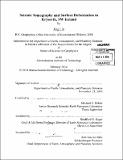| dc.contributor.advisor | Michael C. Fehler and Bradford H. Hager. | en_US |
| dc.contributor.author | Lu, Jing | en_US |
| dc.contributor.other | Massachusetts Institute of Technology. Department of Earth, Atmospheric, and Planetary Sciences. | en_US |
| dc.coverage.spatial | e-ic--- | en_US |
| dc.date.accessioned | 2014-05-23T19:39:18Z | |
| dc.date.available | 2014-05-23T19:39:18Z | |
| dc.date.copyright | 2014 | en_US |
| dc.date.issued | 2013 | en_US |
| dc.identifier.uri | http://hdl.handle.net/1721.1/87506 | |
| dc.description | Thesis: S.M. in Geophysics, Massachusetts Institute of Technology, Department of Earth, Atmospheric, and Planetary Sciences, 2013. | en_US |
| dc.description | Cataloged from PDF version of thesis. | en_US |
| dc.description | Includes bibliographical references (pages 59-62). | en_US |
| dc.description.abstract | The Krýsuvík region of southwestern Iceland is a region of high potential for geothermal energy that is currently experiencing seismic swarm activity and active surface deformation. Understanding the subsurface structure of the area is of great scientific and practical significance. Using permanent and temporary seismic stations deployed in the region, we captured an earthquake swarm from Nov. 2010 to Feb. 2011 clustered around the center of the Krýsuvík volcanic system. We studied the seismicity and Vp, Vs and Vp/Vs ratio in this region by applying double difference tomography. Our tomography result indicates a low velocity zone at a depth of about 6 kin, directly beneath the earthquake swarm. At the same time, our relocation result delineates strike-slip and dip-slip faults above and around this low velocity zone. Brittle-ductile transition is delineated based on the distribution of the earthquakes in this area. In order to understand the relation between the subsurface structure and the surface deformation, we modeled surface deformation using the input parameters constrained from our tomography results. We found that the main deformation is well captured by a pressure source yielding a volume expansion of about 30x 106 m3 at the depth of about 6 km, centered on the low velocity zone detected in tomography. And the secondary deformation could be explained by the normal and the right-lateral slip faults, whose patterns are delineated by the earthquake relocations. The combination of the local stress caused by the expanding source and regional stress that yields a combination of left-lateral shear and extension might have triggered the earthquakes. Based on the low Vp, Vs and possibly high Vp/Vs ratio at depth of ~6 km and its expanding property, the possibilities of supercritical water, H₂O-rich partial melting with magma intrusion are discussed. The results of this thesis provide new insights to understand the seismicity and surface deformation in volcanic zones as well as provided important reference in exploration of new geothermal areas. | en_US |
| dc.description.statementofresponsibility | by Jing Liu. | en_US |
| dc.format.extent | 62 pages | en_US |
| dc.language.iso | eng | en_US |
| dc.publisher | Massachusetts Institute of Technology | en_US |
| dc.rights | M.I.T. theses are protected by copyright. They may be viewed from this source for any purpose, but reproduction or distribution in any format is prohibited without written permission. See provided URL for inquiries about permission. | en_US |
| dc.rights.uri | http://dspace.mit.edu/handle/1721.1/7582 | en_US |
| dc.subject | Earth, Atmospheric, and Planetary Sciences. | en_US |
| dc.title | Seismic tomography and surface deformation in Krýsuvík, SW Iceland | en_US |
| dc.type | Thesis | en_US |
| dc.description.degree | S.M. in Geophysics | en_US |
| dc.contributor.department | Massachusetts Institute of Technology. Department of Earth, Atmospheric, and Planetary Sciences | |
| dc.identifier.oclc | 879669048 | en_US |
